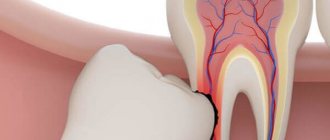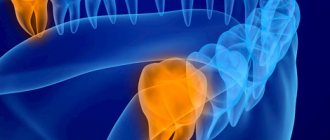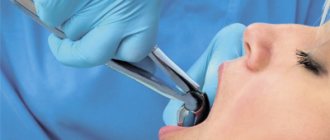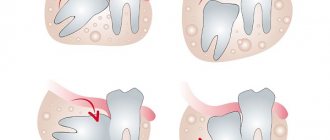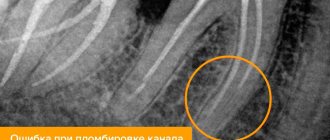From this article you will learn:
- symptoms of wisdom tooth growth,
- what to do if your wisdom tooth is cutting out and your gums are swollen or you have a fever.
The article was written by a dental surgeon with more than 19 years of experience.
The wisdom tooth is located at the very end of the dentition, and therefore it is often called the “figure eight” (the serial numbers of the teeth are assigned starting from the central incisors). Thus, a person has only 4 wisdom teeth - one on each side of the upper and lower jaw. No other teeth cause us so much discomfort and pain when they begin to erupt. It most often occurs between the ages of 18 and 21, but can occur at 14 or 40 years of age.
It is interesting that the incidence of difficult wisdom teeth eruption increases with each generation. This is due to the chewing load, and the fact that people are increasingly eating too soft, overly processed food. As a result, the chewing load that the teeth transmit to the bone tissue of the jaws turns out to be insufficient, which leads to a gradual decrease in the mass and volume of the bone, including a decrease in the length of the lower jaw. As a result, with the same number of teeth, we have less and less space for their eruption.
How a wisdom tooth is cut: photo, x-ray
As a result, competition arises between teeth for a place in the dentition, and those teeth that erupt last are in the most disadvantageous position. Most people are familiar with the fact that when a wisdom tooth is cut, the symptoms of eruption and associated inflammation can cause a lot of inconvenience. And this is not only pain, suppuration or just felt discomfort. If there is not enough space in the dentition, the erupting wisdom teeth put pressure on the teeth in front, moving them to the center of the dentition. It is for this reason that many patients experience crowding of their front teeth over time.
A few facts about wisdom teeth –
Wisdom teeth are the only teeth in which the formation of germs does not occur during intrauterine development, but already in a born child at the age of 4-5 years.
In this case, the crown part of the wisdom tooth completes its formation at the age of 12 years, and the end of the formation of the roots usually occurs no earlier than 24 years. On the x-ray you can see a wisdom tooth whose roots have not yet completed formation (compare with the roots of the 7th tooth in front). Well, the last feature that we talked about above is that the eruption of all other teeth in the permanent dentition occurs in the period from 6 to 13 years, and only the eighth teeth usually begin to erupt no earlier than 18-21 years.
Symptoms of wisdom teeth erupting
Features of growth
Symptoms of the appearance of wisdom teeth
If your wisdom tooth grows incorrectly
How to relieve pain when wisdom teeth erupt
If a wisdom tooth grows during pregnancy
Eights, also known as wisdom teeth or third molars, are the most “problematic” teeth. They are the last to erupt, from about 16 to 30 years of age. At this age, the jaw is already formed, so the eights simply do not have enough space in the dentition, so when they appear, they begin to cause discomfort.
Ways to fight
You can reduce pain symptoms before going to the doctor. To do this, gently massage the problem area with a piece of ice. Before the procedure, hands are washed with soap and disinfected. The movements are performed in a circle. The procedure helps relieve pain for 15-30 minutes without harm to health.
Do not intensively rub ice on the inflamed area. Otherwise, you can damage the hood of the wisdom tooth and cause increased bleeding and swelling. Massage using ice is performed for 5 minutes 3-5 times a day.
Before rubbing, nails must be trimmed to prevent injury to the mucous membranes and the spread of infection throughout the oral cavity. During your examination, your dentist will recommend a suitable anti-inflammatory ointment to relieve swelling in your gums and palate. Instead of an ice massage, mint candies or ice cream are dissolved. The products temporarily reduce the sensitivity of the problem area.
To properly grind food, it is not necessary to have a full row in your mouth. 28 teeth are enough for high-quality chewing of food, so when the first signs of pain in the eights appear, you should immediately visit a doctor so that he can assess the situation. It is advisable to insist on preserving the unit only if a person is diagnosed with multiple absences of teeth in a row. In this case, figure eights can be used as a basis for prosthetics. In this case, it is better to treat the elements, even if they are affected by caries or pulpitis. In other situations, it would be more advisable to remove third molars, since the consequences of their improper eruption are much more dangerous than the potential benefits of their presence in the row.
Features of growth
Unlike molars, eights do not have milk precursors in their buds. They erupt after the permanent teeth appear. You can see how this happens in the picture.
Eruption of wisdom teeth depending on age
When molars emerge, a crown forms on the third molar. Then, after a few years, roots begin to grow. Only after the wisdom tooth inside has fully formed does it begin to erupt.
"Eights" have long lost their functionality
In ancient times, people ate raw meat, roots, and they needed massive molars to chew solid food. Over time, people began to consume thermally processed, softer foods, and the urgent need for the most distant units disappeared. However, you should not completely discount them.
Despite the fact that they themselves do not take much part in chewing food, “eights” restrain the loosening of the teeth, which bear the main chewing load. And in old age they can serve as a support for a bridge.
Difficulties that arise during the appearance of eights
| Pericoronitis. This is an inflammation of the gum tissue surrounding the visible part of the tooth. If you delay a visit to the dentist, purulent inflammation (abscess or phlegmon) may appear. Manifestation of pericoronitis: severe pain when opening the mouth or while eating, bad breath. In most cases, this disease occurs in 80% of people when the lower eights erupt. |
| Dystopia of the tooth. This is an incorrect position of the tooth in the jaw, that is, the eights can be located horizontally or at an angle. Over time, they begin to push against neighboring ones, leading to their destruction. Most often, dystopia is inherited. To avoid complications, it is recommended to remove dystopic wisdom teeth. |
| Retention. This is when the tooth has partially erupted or not erupted at all. If the tooth does not hurt and does not interfere with its neighbors, then it can be left. Conversely, if a tooth causes unbearable pain and destroys the roots of an adjacent tooth, then it should be removed. |
| Hidden caries . An affected wisdom tooth can cause caries to spread to other teeth; in this case, it is better to remove the tooth. |
Appearance time and quantity
They can erupt at 18, 25, 30, 40 years old, or they may be absent from a person’s jaws throughout his entire life. Usually there are four of them (two at the top and two at the bottom). This is the number that is considered the norm, since together with the rest of its “brothers” it amounts to 32 teeth. However, there may be more wisdom teeth. Some people develop one or two ninth teeth over time, while others
the number of teeth in this group can reach 10! In general, the presence or absence of wisdom teeth, the time of their appearance and the number depend, first of all, on hereditary factors, as well as on the size and shape of the jaws.
It is also interesting that by the age of three, the rudiments of molars begin to form in a person. It is during this period of time that the picture becomes clearer with the further formation of at least one wisdom tooth and the total number of such already embedded teeth. And by about 12 years of age, when all the other molars have already erupted and play an important role in chewing food, the formation of the crown of the wisdom tooth is nearing completion.
Symptoms of the appearance of wisdom teeth
As a rule, the eruption of figure eights is accompanied by certain symptoms.
Pain in the gums.
It can be different: aching, pulsating or sharp. This all lasts for several days, or maybe the entire time the tooth grows.
Swelling and swelling.
Sometimes during the period of teething, swelling or swelling appears on the gums. In case of severe swelling, which is accompanied by severe pain and fever, it is recommended to consult a doctor.
Increased body temperature.
An abnormally growing wisdom tooth may be accompanied by an increase in temperature. If the values do not go beyond 38 degrees, there is no need to worry - this is the norm. If the readings are higher, you should make an appointment with your dentist.
A sore throat.
Occurs during an infectious process. During teething, the mucous membrane is very vulnerable, so during this period it is necessary to devote more time to hygiene in order to avoid infection.
Eighth teeth are more likely than others to suffer from caries and other diseases.
This is due to their remote location and the inability to thoroughly clean them. Which leads to a large accumulation of bacteria and the development of caries, gingivitis, and periodontitis. Treatment in such situations is possible, but filling is often complicated by twisted roots and canals. Also, many people cannot open their mouths wide enough or some have a pronounced gag reflex - this significantly complicates the dentist’s work. Due to objective reasons, the “eights” are treated poorly.
Therefore, if the patient wants to keep the unit, a consultation with a dentist is required, who can professionally assess the situation and make the right decision.
If your wisdom tooth grows incorrectly
Complications often arise when figure eights are cut out incorrectly.
- Flux is a purulent inflammation of the periosteum.
- Cellulitis is a purulent inflammation, which is accompanied by an increase in temperature to 39 degrees and swelling of the face.
- Osteomyelitis is an inflammatory disease that affects bone tissue. Main symptoms: fever, nausea, vomiting, diarrhea.
If unpleasant symptoms occur, it is recommended to make an appointment with a dentist-surgeon. He will assess the condition of the tooth and help avoid the risks of complications. You can make an appointment with our specialists by calling: 220-86-30.
Removing "eights" is always difficult
If the unit is located correctly and does not have serious pathologies, it will not be difficult to remove it. To carry out the removal without the risk of complications, before the procedure the patient is prescribed an X-ray of the tooth.
However, most often the third molar grows incorrectly, partially erupts or becomes intertwined with neighboring roots. In this case, the intervention will be carried out in a complex way. The final decision on the choice of method is made by the doctor after examination and obtaining the results of an x-ray of the tooth.
When using a complex method, manipulations are performed in the following sequence:
- The gum is cut and peeled away from the bone.
- To access the roots, a hole is drilled into the bone.
- The unit is extracted (in whole or in parts).
- The wound is treated and stitches are applied.
The procedure can take from 20 minutes to 2 hours. Everything is individual and only an experienced doctor can professionally perform the removal. Therefore, you should be careful when choosing a clinic and specialist.
After surgery, it is recommended to eat soft foods and refrain from physical activity for several days. Antibacterial therapy may be prescribed for prophylactic purposes. Pain and swelling persist for 3-4 days and then gradually disappear.
Visiting the dentist immediately after the figure eight begins to erupt will save you from many serious complications.
Complex dentistry "Sanident" invites all residents of Ivanteevka and Shchelkovo to use the services of experienced dentists who can cope with any dental disease.
How to relieve pain when wisdom teeth erupt
The easiest way to get rid of unpleasant symptoms is to take over-the-counter painkillers.
- To relieve pain and fever: Nurofen, Ibuprofen, Nimesulide, Paracetamol.
- To eliminate pain: “Spazmalgon”, “Ketanov”, “Analgin”, “Pentalgin”, etc.
- Antiseptics to relieve symptoms and prevent complications: Miramistin, Chlorhexidine, Furacilin, etc.
- For local pain relief: “Kamistad”, “Kalgel”, “Cholisal”.
You can use folk remedies.
- Rinse solution made from salt and soda. Dissolve 1 teaspoon of salt and soda in a glass of warm water. It is recommended to rinse your mouth no more than 3 times a day.
- Rinse solution made from propolis tincture. Stir 7-8 drops of tincture in a glass of warm water. The solution is also a natural antiseptic.
- Cold compress. Under no circumstances should it be hot - heat may cause inflammation.
- Sage decoction. Pour 1 tablespoon of sage into a glass of boiling water, leave for an hour, strain. You can rinse until relief occurs.
Relieving pain during wisdom tooth eruption is only a short-term solution. A competent consultation with a doctor will help you cope with pain and possible complications.
Post-operative care
After wisdom tooth removal, many patients experience severe pain for several days. Painful sensations affect not only the jaw, but also spread to the head, throat, and ear. You can take painkillers for three days, but if the pain does not go away, you should seek help from a specialist.
To alleviate the condition after surgery, you must follow these recommendations:
- When a wisdom tooth is removed, it is forbidden to touch the site of its removal with your tongue or fingers for 4 hours after the operation.
- After removing the “eight”, you need to apply a cold compress to your cheek every 20 minutes throughout the day. Such actions will reduce the intensity of pain and relieve inflammation.
- After the operation, it is forbidden to eat for the next 3 hours, and during the day, avoid drinking alcohol and stop smoking.
- Avoid excessive activity of facial expressions for several days.
In rare cases, a wisdom tooth after removal can cause the development of sore throat and inflammation of the tonsils. For such complications, special therapy is required.
This article is for informational purposes only, please consult your doctor for details!
Other publications:
- How to brush your teeth correctly?
- The period of changing teeth in a baby: diagram, approximate timing of the process of tooth loss in babies, advice from a doctor on caring for the oral cavity.
If a wisdom tooth grows during pregnancy
If the eights began to grow during pregnancy, then the expectant mother should make an appointment with a doctor. This will help protect the baby from negative consequences and significantly improve the well-being of the pregnant woman. If there are unpleasant symptoms (improper position, pain, inflammation), the dentist may recommend removing the wisdom tooth. In this case, it is better to do this in the second trimester, when the operation will not harm either the mother or the child. At other times, it is not recommended to carry out any procedures unless there is a threat to the health of the woman and baby.
